Dishwasher tank: causes and options for breakdowns + ways to fix them
A dishwasher is a worthwhile, attractive task that removes unnecessary worries about caring for dishes.However, there is no equipment that functions flawlessly throughout its entire operational life. Often problems arise from the dishwasher tank. The owner should know what to do in such a situation. Do you agree?
We will tell you what breakdowns you can fix yourself without any problems. We will tell you in which cases it is better to entrust repairs to a representative of a service workshop. Taking into account our advice, in any case, you can quickly restore the machine’s functionality with your own hands or fix everything with the help of a specialist.
The content of the article:
Briefly about the design of the dishwasher
Despite the kind of magic that a dishwasher bestows on housewives in the kitchen, this technique is, from a technical point of view, quite simple.
It is essentially a waterproof box-shaped bathtub with hot water sprayed inside.
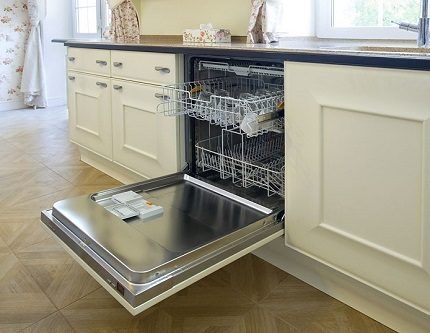
As a rule, an aqueous soap solution is used, which promotes better dishwashing. This solution, passed through nozzles, is used to spray the cleaning objects. Dirty water collects at the bottom of the tank, is sucked into the pump and removed. Then the drying process starts.
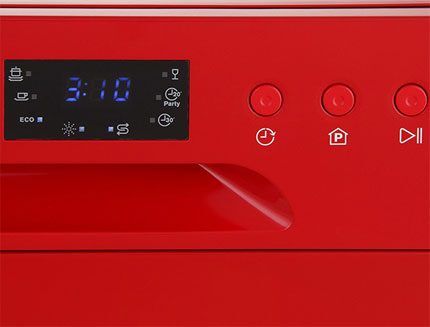
The system is controlled using automation, the level of complexity of which depends on the manufacturer and model project. In detail with the general principle of operation of dishwashers of various brands read the articlededicated to this interesting issue.
Automatic controls include different functions as needed:
- spraying water;
- loading detergent from the dispenser;
- removing water from the tank;
- pumping water;
- filling with water and removing it;
- turning on the heating element.
Hot water is poured into the dishwasher through a supply hose, which is connected through a shut-off valve. water supply tap with centralized water supply.
Additionally, the water supply is controlled by the dishwasher inlet valve installed inside - under its body. The intake valve is electronically controlled and linked to the basic design components.
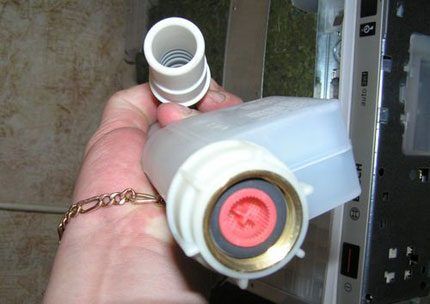
The valve opens and closes, for example, as water is required for the rotating spray arms. The spray system contains nozzles, usually located at the top and bottom of the tank.
The jets and water pump create high water pressure inside the dishwasher tank, allowing the dishes to be washed clean.
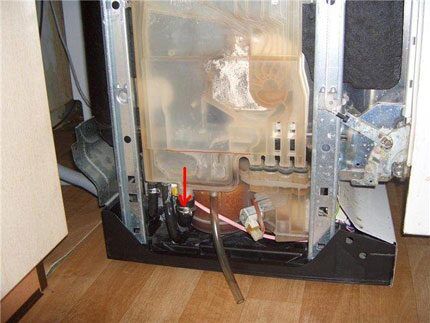
The dishwasher tank is actually the main structural element, since all other elements are schematically arranged around it. Therefore, it is logical to consider first the malfunctions associated with the tank and the possible causes of their occurrence.
Tank breakdowns and their elimination
Technically, it is correct to call this part not a tank, but a working chamber or bath. Considering the need to seal the working chamber, it becomes clear that one of the primary malfunctions that may occur during operation is depressurization.
Problem #1 - water on the floor
The working chamber of the machine has a loading hatch. When the washing machine is loaded with dishes, the hatch should be tightly closed with the door. The seal is ensured by a special sealing gasket.
But over time, it may lose its properties. When the sealing gasket wears out, the seal of the hatch-door module is compromised. The consequences of such a defect are obvious. During the washing process, water seeps through the disturbed areas and flows onto the kitchen floor.
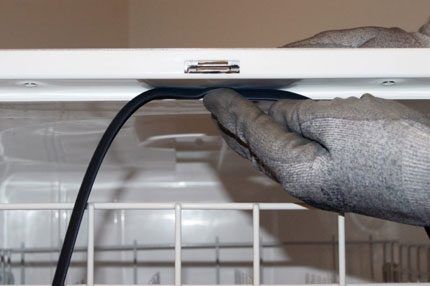
It is easy to detect such a malfunction. If water appears on the floor under the dishwasher, you should carefully inspect the perimeter of the loading hatch to determine where dishwasher needs repairt, and where the tightness is not broken.
It’s better to take a piece of toilet paper, crumple it in your palm and smoothly walk around the perimeter of the loading door with the resulting “crumb”. In places of leakage, the paper will certainly get wet - it will show points of depressurization.
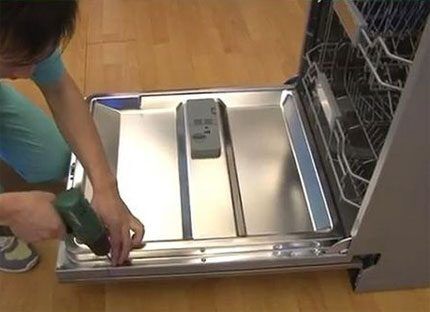
It is possible to eliminate the defect associated with depressurization of the loading hatch only by replacing the sealing material. Attempting to use some kind of overlay will lead to nothing.
Moreover, such repair options will only worsen the situation. True, sometimes the tightness is restored after carefully adjusting the pressure of the door to the hatch window.
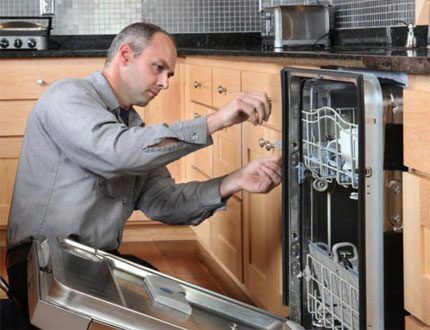
Defects associated with depressurization of the dishwasher tank may also appear in other places. For example, at the water supply connection point or at the supply points to spray hoses.
As a rule, the supply unit with filters is located under the bottom of the tank and is connected to the working chamber through a transition, also equipped with a seal. If it becomes damaged, leakage is inevitable.
Problem #2 - lack of water supply/drainage
To start the washing process, there must be a certain level of water inside the machine tank, which is detected by a level sensor. If the tank is not filled to this level, the automation will not start the dishwasher.
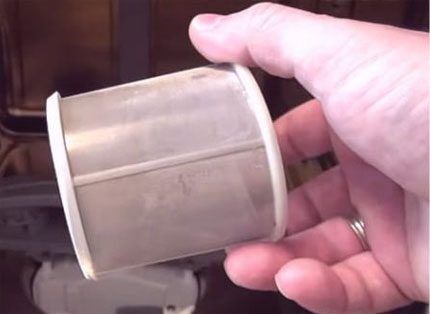
The traditional reason for lack of water is a clogged filter. Solving this problem is not difficult. You just need to open the filter and clean or replace its elements. If everything is normal with the working water level in the tank, but the automation still does not give the go-ahead to start, most likely the cause is a malfunction of the water pump.
The liquid collected to the required tank level must be supplied to the nozzles using a pump. If this does not happen, then you should pay attention to the pump and the injector holes. Perhaps the sprinklers are simply clogged with dirt.

Another defect, which can also be attributed to the working chamber and which is associated with water circulation, is the lack of drainage of waste liquid or, on the contrary, its overflow. The sump design is also equipped with a level sensor (float).
If it is working properly, then when a certain level is reached, the drainage pump turns on and removes waste water. In case of poor-quality drainage or complete absence, for example, due to a faulty pump, an overflow effect occurs. The sensor is triggered and activates the automatic warning function.
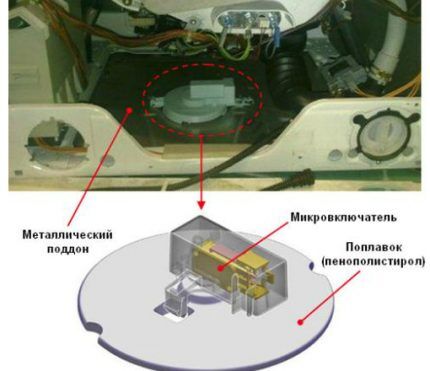
So, damage to the float sensor cannot be ruled out, and such cases are not isolated in practice. The result is still the same: a non-working machine or a water leak on the floor.
Where to look and how to choose wisely spare parts for dishwasher repair? You will find practical advice and recommendations in the article we proposed for consideration.
Problem #3 - physical defects in the working chamber
This type of failure is a rare event. However, such incidents do happen. Typically, physical damage to the dishwasher tank occurs during its long-term operation. That is, time does its job - materials wear out.
The lion's share of cases of physical wear of the tank occurs in structures made of the now popular plastic. It is the plastic working chamber, having worked for an average of 3-5 years, that can crack due to frequent temperature changes and exposure to chemicals added during the washing process.

With such a defect, the dishwasher technically operates as usual. The washing process is not disrupted.
But water invariably accumulates on the floor of the unit. The more cracks on the tank body, the larger the puddle and the more often the mains supply turns on. The only way to get rid of such a malfunction is to completely replace the working chamber.
It is difficult to do such work with your own hands, since you have to disassemble the machine almost completely. Therefore, replacement of a washing bath is most often carried out through service departments.
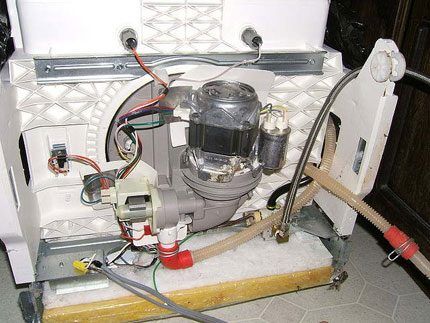
You can completely eliminate the problem with a physical defect in the working chamber in a simple way - when purchasing, choose a model that uses a working washing bath made of stainless steel.
Problem #4 - poor dishwashing
How can we explain the poor quality of washing dishes by machine? The working chamber in such cases seems to have nothing to do with it. At first glance, this is true, unless you take into account that the electric heater (TEH) is built into the body of the tank, and not into another part of the dishwasher.
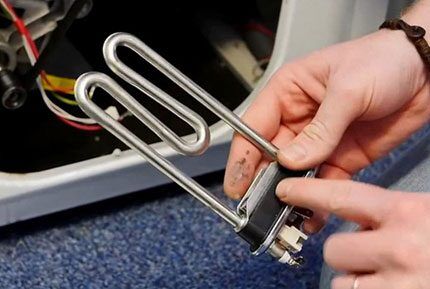
So, if the water temperature during the dishwashing process does not reach 60 °C, then there is every reason to see dirty plates/cups/glasses at the end of the washing cycle.
The inability to reach the optimal temperature is evidence of a failed heater. Such a malfunction can only be determined by using a special power tool - a tester.
In addition, trying to determine the integrity of an electric heater is strictly not recommended for people who are not friends with electricity. This is the work of the service center technicians. The electric heating element should be tested with a tester to make sure that it is completely faulty.Then the heater must be replaced with a new one.
Most cars produced these days are equipped with breakdown warning systems. How understand the codes, for example, Ariston Hotpoinnt dishwashers, you will find out by reading the very useful information we offer.
How to replace the heating element of a Bosch brand dishwasher is written in detail in next article, the contents of which we recommend that you familiarize yourself with. The selection tips and technological subtleties given in it will help you cope with the problem yourself.
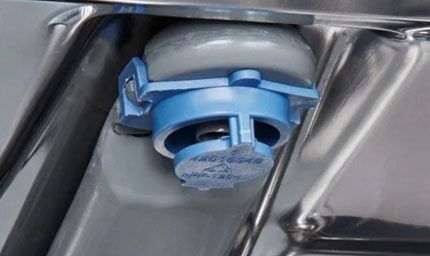
Poor quality washing of sets and other table accessories loaded into the machine is also possible due to partial clogging of the nozzle holes. With such a defect, the dishes also come out of the tank with food residues, since during the washing process the water jets simply do not capture the dishes entirely.
The solution here is to disassemble the sprinklers and clean out the clogged holes. You can do this work yourself.
Helpful tips and proven solutions Elektrolux dishwasher breakdowns, characteristic of machines of the specified brand, will help their owners restore the operation of household appliances.
Conclusions and useful video on the topic
In this video, the author talks about all the intricacies of repairing a dishwasher at home. Popularly explains the details of the functioning of machine blocks and explains how to carry out repairs yourself:
Video about eliminating such a problem as the appearance of leaks in the tank of the machine (part one):
Further work to eliminate tank leaks (part two):
Breakdowns of a machine designed to wash tableware most often occur at points of the structure directly connected to the working chamber (washing bath). This part of the dishwasher has to be repaired after the first 2-3 years of operation, and after the same amount of time, some parts need to be replaced.
A dishwasher is a convenient appliance that significantly increases the degree of comfort. However, in any case, you have to pay for comfort in time and money spent on troubleshooting.
Tell us how you dealt with a typical dishwasher malfunction with your own hands. Share your proven method for troubleshooting. Please leave comments in the block below, ask questions, post photos on the topic of the article.



